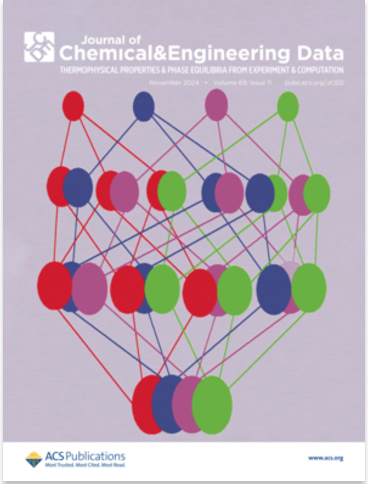Discovery of HDM2010, a highly potent PTPN2 inhibitor for immunotherapy.
IF 2.1
3区 工程技术
Q3 CHEMISTRY, MULTIDISCIPLINARY
Journal of Chemical & Engineering Data
Pub Date : 2024-06-01
DOI:10.1200/jco.2024.42.16_suppl.e15021
引用次数: 0
Abstract
e15021 Background: Protein tyrosine phosphatase non-receptor type 2 (PTPN2), a negative regulator of JAK–STAT pathways that plays a crucial role in the immune system, has been identified as a promising target for immunotherapy. Genetic deletion of PTPN2 in either tumor cells or host immune cells promotes the anti-tumor immunity. In addition, PTPN2 inhibitors, alone or in combination with anti-PD1 therapy, significantly reduced tumor growth and enhanced survival in several subcutaneous tumour models. These findings demonstrate that PTPN2 inhibitors may have clinical benefits for immunotherapy-resistant tumors. Herein, the discovery of a series of novel PTPN2 inhibitors and their implications for immunotherapy are reported. Methods: We have successfully developed a series of small molecule inhibitors that specifically target PTPN2/N1. Molecular design was based on a novel backbone and incorporating both structure-based drug design (SBDD) and computational chemistry techniques. To evaluate the efficacy of our inhibitors, PTPN2 phosphatase activity was monitored using the small-molecule substrate DiFMUP in a fluorescence assay format in vitro. Tumor cells were treated with IFNγ and the cell viability was measured. Pharmacokinetic studies were conducted in mice, with serial blood samples analyzed by liquid chromatography−mass spectrometry (LC−MS)/MS. Pharmacokinetic parameters were calculated by noncompartmental analysis. Results: Based on the co-crystal structure of this target reported and multiple previous research projects, we have designed a multitude of novel compounds with the employment of computer-aided drug design (CADD) and scaffold hopping. Through a comprehensive evaluation of the in vitro and in vivo parameters, we have identified a series of compounds displaying potent PTPN2 inhibition (IC50 < 10 nM). Moreover, the compounds displayed remarkable efficacy in killing tumor cells to IFNγ treatment (IC50 < 100 nM). Artificial intelligence was utilized to conduct assessment and prediction of ADME properties, improving the drug-ability including permeability and physicochemical properties. Currently, a series of compounds demonstrating outstanding potency and good pharmacokinetic profiles, with lower hERG blockage (hERG IC50 > 30 µM), were synthesized and characterized. Among these hit compounds, a leading compound with PTPN2 IC50 = 1.1 nM and tumor cells IC50 = 79.5 nM was identified for further optimization and evaluation. Conclusions: We reported our work on discovering HDM2010, in which a series of potent PTPN2 inhibitors with prominent PK and safety profile were synthesized and characterized. Further optimization including in vivo experiments will lead to a preclinical candidate (PCC) selection.发现用于免疫疗法的高效 PTPN2 抑制剂 HDM2010。
e15021 背景:蛋白酪氨酸磷酸酶非受体2型(PTPN2)是JAK-STAT通路的负调控因子,在免疫系统中发挥着至关重要的作用。在肿瘤细胞或宿主免疫细胞中遗传性删除 PTPN2 可促进抗肿瘤免疫。此外,在几种皮下肿瘤模型中,PTPN2抑制剂单独或与抗PD1疗法联合使用,都能显著降低肿瘤生长并提高存活率。这些发现表明,PTPN2 抑制剂可能对免疫疗法耐药的肿瘤有临床疗效。本文报告了一系列新型 PTPN2 抑制剂的发现及其对免疫疗法的影响。方法:我们成功开发了一系列特异性靶向 PTPN2/N1 的小分子抑制剂。分子设计以新型骨架为基础,并结合了基于结构的药物设计(SBDD)和计算化学技术。为了评估我们抑制剂的疗效,我们在体外使用小分子底物 DiFMUP 以荧光测定法监测 PTPN2 磷酸酶的活性。用 IFNγ 处理肿瘤细胞并测量细胞活力。药代动力学研究是在小鼠体内进行的,采用液相色谱-质谱联用仪(LC-MS)/MS 分析连续血液样本。药代动力学参数通过非室分析法计算。结果根据该靶标的共晶体结构以及之前的多个研究项目,我们利用计算机辅助药物设计(CADD)和支架跳转技术设计了多种新型化合物。通过对体外和体内参数的综合评估,我们确定了一系列对 PTPN2 具有强效抑制作用(IC50 < 10 nM)的化合物。此外,这些化合物对 IFNγ 处理的肿瘤细胞具有显著的杀伤效果(IC50 < 100 nM)。利用人工智能对 ADME 特性进行评估和预测,提高了药物的可药性,包括渗透性和理化特性。目前,已合成并表征了一系列具有出色药效和良好药代动力学特征、较低 hERG 阻断率(hERG IC50 > 30 µM)的化合物。在这些命中化合物中,确定了一个 PTPN2 IC50 = 1.1 nM 和肿瘤细胞 IC50 = 79.5 nM 的主要化合物,以便进一步优化和评估。结论:我们报告了发现 HDM2010 的工作,其中合成并表征了一系列具有突出 PK 和安全性特征的强效 PTPN2 抑制剂。包括体内实验在内的进一步优化将导致临床前候选药物(PCC)的选择。
本文章由计算机程序翻译,如有差异,请以英文原文为准。
求助全文
约1分钟内获得全文
求助全文
来源期刊

Journal of Chemical & Engineering Data
工程技术-工程:化工
CiteScore
5.20
自引率
19.20%
发文量
324
审稿时长
2.2 months
期刊介绍:
The Journal of Chemical & Engineering Data is a monthly journal devoted to the publication of data obtained from both experiment and computation, which are viewed as complementary. It is the only American Chemical Society journal primarily concerned with articles containing data on the phase behavior and the physical, thermodynamic, and transport properties of well-defined materials, including complex mixtures of known compositions. While environmental and biological samples are of interest, their compositions must be known and reproducible. As a result, adsorption on natural product materials does not generally fit within the scope of Journal of Chemical & Engineering Data.
 求助内容:
求助内容: 应助结果提醒方式:
应助结果提醒方式:


